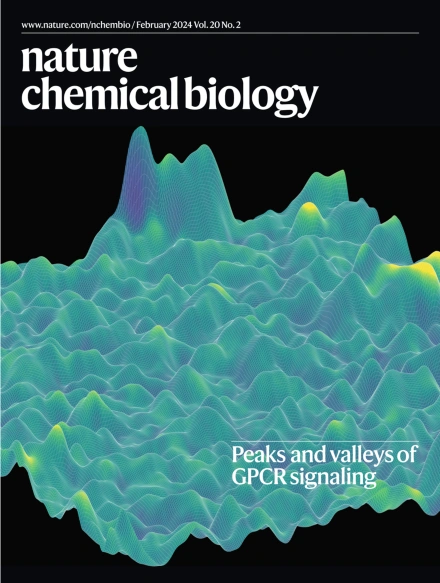Cell-selective multiplexed bioorthogonal noncanonical amino acid tagging for nascent proteomics.
IF 13.7
1区 生物学
Q1 BIOCHEMISTRY & MOLECULAR BIOLOGY
引用次数: 0
Abstract
Cell-selective bioorthogonal noncanonical amino acid tagging (BONCAT) enables time-resolved characterization of newly synthesized proteins using engineered aminoacyl-tRNA synthetases. In bacteria, this is typically accomplished using an engineered methionyl-tRNA synthetase (MetRS-NLL). Here we substantially expand the scope of this technology by introducing an engineered tyrosyl-tRNA synthetase (EcTyrRS) and a tryptophanyl-tRNA synthetase (EcTrpRS). These enzymes enable the ultrafast proteome tagging at much lower expression levels than MetRS-NLL, thereby improving both time resolution and robustness in nonmodel bacteria. Additionally, both enzymes can incorporate multiple different noncanonical amino acids with distinct click handles. This enabled new multiplexing capabilities such as distinct tagging of the nascent proteome generated in a cell in response to different cues, and tighter temporal control through pulse-chase BONCAT. EcTyrRS and EcTrpRS are also mutually orthogonal, enabling distinct proteome tagging of different cell types in mixed populations. We therefore demonstrate the utility of this technology in Escherichia coli and nonmodel ESKAPE pathogens.新生蛋白质组学的细胞选择性多重生物正交非规范氨基酸标记。
细胞选择性生物正交非规范氨基酸标记(BONCAT)能够利用工程氨基酰基- trna合成酶对新合成的蛋白质进行时间分辨表征。在细菌中,这通常是使用工程化的甲硫基trna合成酶(mets - nll)来完成的。在这里,我们通过引入工程酪氨酸- trna合成酶(EcTyrRS)和色氨酸- trna合成酶(EcTrpRS),大大扩展了这项技术的范围。这些酶能够在比ms - nll低得多的表达水平下实现超快蛋白质组标记,从而提高了非模式细菌的时间分辨率和稳健性。此外,这两种酶都可以结合多种不同的非规范氨基酸,具有不同的点击手柄。这使得新的多路复用功能得以实现,例如对细胞中响应不同信号而产生的新生蛋白质组进行不同的标记,以及通过脉冲追踪BONCAT进行更严格的时间控制。EcTyrRS和ectrpr也是相互正交的,可以在混合群体中对不同细胞类型进行不同的蛋白质组标记。因此,我们证明了该技术在大肠杆菌和非模型ESKAPE病原体中的实用性。
本文章由计算机程序翻译,如有差异,请以英文原文为准。
求助全文
约1分钟内获得全文
求助全文
来源期刊

Nature chemical biology
生物-生化与分子生物学
CiteScore
23.90
自引率
1.40%
发文量
238
审稿时长
12 months
期刊介绍:
Nature Chemical Biology stands as an esteemed international monthly journal, offering a prominent platform for the chemical biology community to showcase top-tier original research and commentary. Operating at the crossroads of chemistry, biology, and related disciplines, chemical biology utilizes scientific ideas and approaches to comprehend and manipulate biological systems with molecular precision.
The journal embraces contributions from the growing community of chemical biologists, encompassing insights from chemists applying principles and tools to biological inquiries and biologists striving to comprehend and control molecular-level biological processes. We prioritize studies unveiling significant conceptual or practical advancements in areas where chemistry and biology intersect, emphasizing basic research, especially those reporting novel chemical or biological tools and offering profound molecular-level insights into underlying biological mechanisms.
Nature Chemical Biology also welcomes manuscripts describing applied molecular studies at the chemistry-biology interface due to the broad utility of chemical biology approaches in manipulating or engineering biological systems. Irrespective of scientific focus, we actively seek submissions that creatively blend chemistry and biology, particularly those providing substantial conceptual or methodological breakthroughs with the potential to open innovative research avenues. The journal maintains a robust and impartial review process, emphasizing thorough chemical and biological characterization.
 求助内容:
求助内容: 应助结果提醒方式:
应助结果提醒方式:


